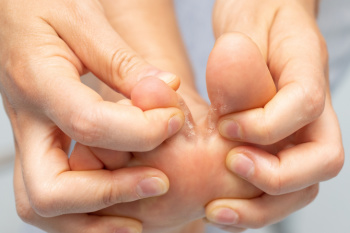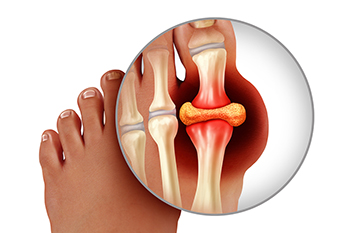Items filtered by date: June 2025
How Rheumatoid Arthritis Affects the Feet

Rheumatoid arthritis is a long-term condition that causes inflammation in the joints, often starting in the feet. In many cases, the toes or middle part of the foot are the first areas to become painful or swollen. The joints most often affected are the ones at the base of the toes, as well as the joints below the ankle. These areas can become stiff, unstable, or painful, and over time, the shape of the foot can change. Some people develop soft lumps, called nodules, that form over pressure points like the heel or the back of the ankle. Fluid-filled sacs under the ball of the foot, known as bursae, may become sore if irritated. Corns, calluses, and thick skin may build up in areas that take extra pressure, especially if walking becomes uneven. A podiatrist can provide support through an accurate diagnosis, pressure relief techniques, and long-term foot care. If you have rheumatoid arthritis that is causing foot pain, it is suggested that you schedule an appointment with a podiatrist for appropriate treatment.
Because RA affects more than just your joints, including the joints in your feet and ankles, it is important to seek early diagnosis from your podiatrist if you feel like the pain in your feet might be caused by RA. For more information, contact Joseph Creswell, DPM of Practice. Our practitioner will assist you with all of your podiatric concerns.
What Is Rheumatoid Arthritis?
Rheumatoid Arthritis (RA) is an autoimmune disorder in which the body’s own immune system attacks the membranes surrounding the joints. Inflammation of the lining and eventually the destruction of the joint’s cartilage and bone occur, causing severe pain and immobility.
Rheumatoid Arthritis of the Feet
Although RA usually attacks multiple bones and joints throughout the entire body, almost 90 percent of cases result in pain in the foot or ankle area.
Symptoms
- Swelling and pain in the feet
- Stiffness in the feet
- Pain on the ball or sole of feet
- Joint shift and deformation
Diagnosis
Quick diagnosis of RA in the feet is important so that the podiatrist can treat the area effectively. Your doctor will ask you about your medical history, occupation, and lifestyle to determine the origin of the condition. Rheumatoid Factor tests help to determine if someone is affected by the disease.
If you have any questions, please feel free to contact our office located in Wallace, ID . We offer the newest diagnostic and treatment technologies for all your foot care needs.
Complications From Athlete’s Foot Blisters

Athlete’s foot can lead to painful blisters that form on the soles of the feet or between the toes. These blisters, often filled with clear or yellowish fluid, may occur even in areas without friction and can become more than just a source of discomfort. When athlete's foot blisters break open, they expose the skin to bacteria, increasing the chance of infection. Signs of a developing bacterial infection may include redness, swelling, pus, or a sensation of warmth in the affected area. In more serious cases, the infection can spread deeper into the foot or affect nearby lymph nodes. These blisters should not be popped, as removing the protective layer increases the risk of complications. Ongoing exposure to moisture and fungi may also lead to repeat infections or allergic reactions, further irritating the skin. A podiatrist can assess blistering caused by athlete’s foot, identify signs of infection, and recommend appropriate treatment. If blisters from an athlete's foot infection are causing problems, it is suggested that you schedule an appointment with a podiatrist for appropriate treatment options.
Athlete’s foot is an inconvenient condition that can be easily reduced with the proper treatment. If you have any concerns about your feet and ankles, contact Joseph Creswell, DPM from Practice. Our practitioner will treat your foot and ankle needs.
Athlete’s Foot: The Sole Story
Athlete's foot, also known as tinea pedis, can be an extremely contagious foot infection. It is commonly contracted in public changing areas and bathrooms, dormitory style living quarters, around locker rooms and public swimming pools, or anywhere your feet often come into contact with other people.
Solutions to Combat Athlete’s Foot
- Hydrate your feet by using lotion
- Exfoliate
- Buff off nails
- Use of anti-fungal products
- Examine your feet and visit your doctor if any suspicious blisters or cuts develop
Athlete’s foot can cause many irritating symptoms such as dry and flaking skin, itching, and redness. Some more severe symptoms can include bleeding and cracked skin, intense itching and burning, and even pain when walking. In the worst cases, Athlete’s foot can cause blistering as well. Speak to your podiatrist for a better understanding of the different causes of Athlete’s foot, as well as help in determining which treatment options are best for you.
If you have any questions please feel free to contact our office located in Wallace, ID . We offer the newest diagnostic and treatment technologies for all your foot and ankle needs.
Stages of Gout and the Podiatrist’s Role in Care

Gout is a form of arthritis caused by the buildup of uric acid crystals in the joints, often affecting the feet. It progresses through four stages known as asymptomatic hyperuricemia, acute gout, intercritical gout, and chronic tophaceous gout. Risk factors include a diet high in purines, obesity, alcohol use, certain medications, and genetic predisposition. Symptoms involve sudden, intense joint pain, swelling, redness, and warmth, usually in the big toe. A podiatrist can help manage gout through joint evaluation, medication recommendations, and dietary guidance. They can also treat complications such as joint damage and tophi, helping to relieve pain, prevent flare-ups, and maintain foot function and mobility. If you have had one or more gout flare ups, it is strongly suggested that you are under the care of a podiatrist who can help you to manage this painful condition.
Gout is a foot condition that requires certain treatment and care. If you are seeking treatment, contact Joseph Creswell, DPM from Practice. Our practitioner will treat your foot and ankle needs.
What Is Gout?
Gout is a type of arthritis caused by a buildup of uric acid in the bloodstream. It often develops in the foot, especially the big toe area, although it can manifest in other parts of the body as well. Gout can make walking and standing very painful and is especially common in diabetics and the obese.
People typically get gout because of a poor diet. Genetic predisposition is also a factor. The children of parents who have had gout frequently have a chance of developing it themselves.
Gout can easily be identified by redness and inflammation of the big toe and the surrounding areas of the foot. Other symptoms include extreme fatigue, joint pain, and running high fevers. Sometimes corticosteroid drugs can be prescribed to treat gout, but the best way to combat this disease is to get more exercise and eat a better diet.
If you have any questions, please feel free to contact our office located in Wallace, ID . We offer the newest diagnostic and treatment technologies for all your foot care needs.
Causes and Podiatrist Support for Hammertoe

Hammertoes are a common foot deformity where one or more toes become bent at the middle joint, causing them to resemble a hammer. This condition develops when there is an imbalance in the muscles, tendons, or ligaments that normally keep the toe straight. Causes include wearing tight or narrow shoes, foot injuries, or inherited foot structure. Identifying features include a curled toe appearance, corns or calluses on top of the affected joint, and difficulty moving the toe. Symptoms may involve pain, swelling, and discomfort while walking. Risk factors include aging, arthritis, and wearing improper footwear. If you have developed a hammertoe, it is suggested that you contact a podiatrist who can diagnose the condition, recommend proper shoes or custom orthotics, and provide treatments to relieve pain and prevent further deformity.
Hammertoe
Hammertoes can be a painful condition to live with. For more information, contact Joseph Creswell, DPM from Practice. Our practitioner will answer any of your foot- and ankle-related questions.
Hammertoe is a foot deformity that affects the joints of the second, third, fourth, or fifth toes of your feet. It is a painful foot condition in which these toes curl and arch up, which can often lead to pain when wearing footwear.
Symptoms
- Pain in the affected toes
- Development of corns or calluses due to friction
- Inflammation
- Redness
- Contracture of the toes
Causes
Genetics – People who are genetically predisposed to hammertoe are often more susceptible
Arthritis – Because arthritis affects the joints in your toes, further deformities stemming from arthritis can occur
Trauma – Direct trauma to the toes could potentially lead to hammertoe
Ill-fitting shoes – Undue pressure on the front of the toes from ill-fitting shoes can potentially lead to the development of hammertoe
Treatment
Orthotics – Custom made inserts can be used to help relieve pressure placed on the toes and therefore relieve some of the pain associated with it
Medications – Oral medications such as anti-inflammatories or NSAIDs could be used to treat the pain and inflammation hammertoes causes. Injections of corticosteroids are also sometimes used
Surgery – In more severe cases where the hammertoes have become more rigid, foot surgery is a potential option
If you have any questions, please feel free to contact our office located in Wallace, ID . We offer the newest diagnostic and treatment technologies for all your foot care needs.
